2006 CHEVROLET EQUINOX ECU
[x] Cancel search: ECUPage 7 of 382

Front Seats......................................................1-2
Manual Seats................................................1-2
Driver Seat Height Adjuster..............................1-3
Six-Way Power Driver Seat..............................1-3
Manual Lumbar..............................................1-4
Heated Seats.................................................1-4
Reclining Seatbacks........................................1-5
Head Restraints.............................................1-7
Passenger Folding Seatback............................1-8
Rear Seats.....................................................1-10
Split Folding Rear Seat.................................1-10
Safety Belts...................................................1-12
Safety Belts: They Are for Everyone................1-12
Questions and Answers About Safety Belts......1-17
How to Wear Safety Belts Properly.................1-18
Driver Position..............................................1-18
Shoulder Belt Height Adjustment.....................1-24
Safety Belt Use During Pregnancy..................1-25
Right Front Passenger Position.......................1-25
Rear Seat Passengers..................................1-25
Rear Safety Belt Comfort Guides....................1-28
Safety Belt Pretensioners...............................1-29
Safety Belt Extender.....................................1-30Child Restraints.............................................1-30
Older Children..............................................1-30
Infants and Young Children............................1-33
Child Restraint Systems.................................1-36
Where to Put the Restraint.............................1-40
Lower Anchors and Tethers for Children
(LATCH)..................................................1-42
Securing a Child Restraint in a Rear
Seat Position............................................1-50
Securing a Child Restraint in the Right
Front Seat Position....................................1-52
Airbag System...............................................1-55
Where Are the Airbags?................................1-58
When Should an Airbag In�ate?.....................1-61
What Makes an Airbag In�ate?.......................1-62
How Does an Airbag Restrain?.......................1-62
What Will You See After an Airbag In�ates?.....1-63
Servicing Your Airbag-Equipped Vehicle...........1-64
Adding Equipment to Your Airbag-Equipped
Vehicle....................................................1-65
Restraint System Check..................................1-66
Checking the Restraint Systems......................1-66
Replacing Restraint System Parts
After a Crash............................................1-66
Section 1 Seats and Restraint Systems
1-1
Page 14 of 382

Adjust your head restraint so that the top of the restraint
is closest to the top of your head. This position reduces
the chance of a neck injury in a crash.
Passenger Folding Seatback
The front passenger’s seatback may fold �at.
{CAUTION:
If you fold the seatback forward to carry longer
objects, such as skis, be sure any such cargo
is not near an airbag. In a crash, an in�ating
airbag might force that object toward a person.
This could cause severe injury or even death.
Secure objects away from the area in which an
airbag would in�ate. For more information, see
Where Are the Airbags? on page 1-58and
Loading Your Vehicle on page 4-31.
{CAUTION:
Things you put on this seatback can strike
and injure people in a sudden stop or turn,
or in a crash. Remove or secure all items
before driving.
1-8
Page 24 of 382
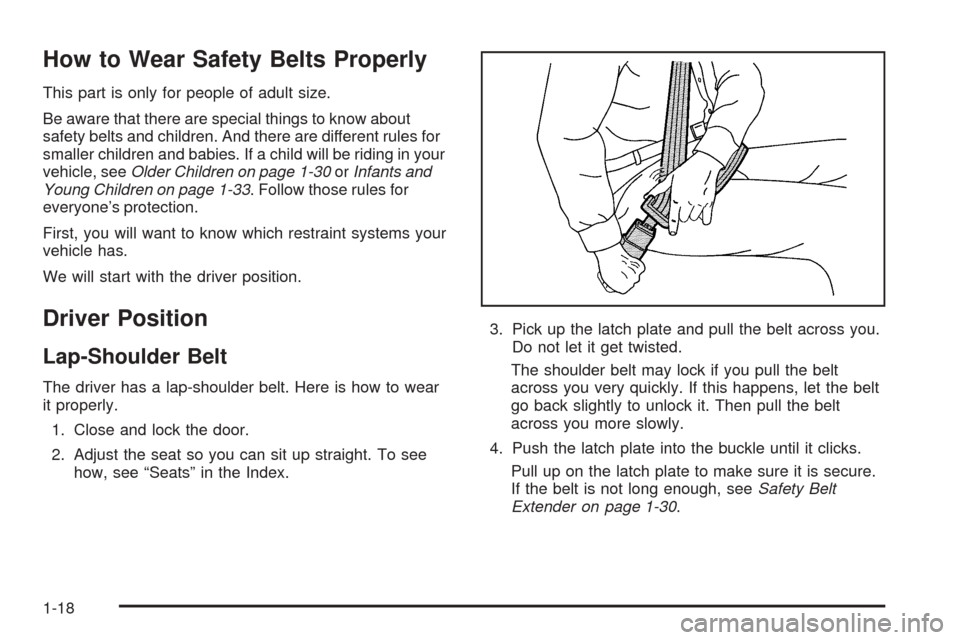
How to Wear Safety Belts Properly
This part is only for people of adult size.
Be aware that there are special things to know about
safety belts and children. And there are different rules for
smaller children and babies. If a child will be riding in your
vehicle, seeOlder Children on page 1-30orInfants and
Young Children on page 1-33. Follow those rules for
everyone’s protection.
First, you will want to know which restraint systems your
vehicle has.
We will start with the driver position.
Driver Position
Lap-Shoulder Belt
The driver has a lap-shoulder belt. Here is how to wear
it properly.
1. Close and lock the door.
2. Adjust the seat so you can sit up straight. To see
how, see “Seats” in the Index.3. Pick up the latch plate and pull the belt across you.
Do not let it get twisted.
The shoulder belt may lock if you pull the belt
across you very quickly. If this happens, let the belt
go back slightly to unlock it. Then pull the belt
across you more slowly.
4. Push the latch plate into the buckle until it clicks.
Pull up on the latch plate to make sure it is secure.
If the belt is not long enough, seeSafety Belt
Extender on page 1-30.
1-18
Page 32 of 382
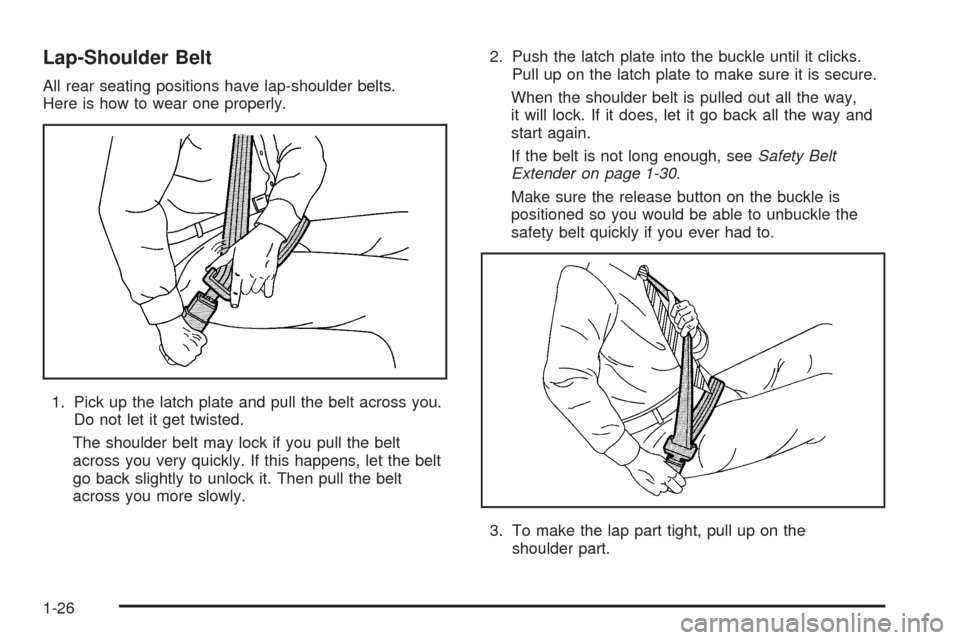
Lap-Shoulder Belt
All rear seating positions have lap-shoulder belts.
Here is how to wear one properly.
1. Pick up the latch plate and pull the belt across you.
Do not let it get twisted.
The shoulder belt may lock if you pull the belt
across you very quickly. If this happens, let the belt
go back slightly to unlock it. Then pull the belt
across you more slowly.2. Push the latch plate into the buckle until it clicks.
Pull up on the latch plate to make sure it is secure.
When the shoulder belt is pulled out all the way,
it will lock. If it does, let it go back all the way and
start again.
If the belt is not long enough, seeSafety Belt
Extender on page 1-30.
Make sure the release button on the buckle is
positioned so you would be able to unbuckle the
safety belt quickly if you ever had to.
3. To make the lap part tight, pull up on the
shoulder part.
1-26
Page 36 of 382
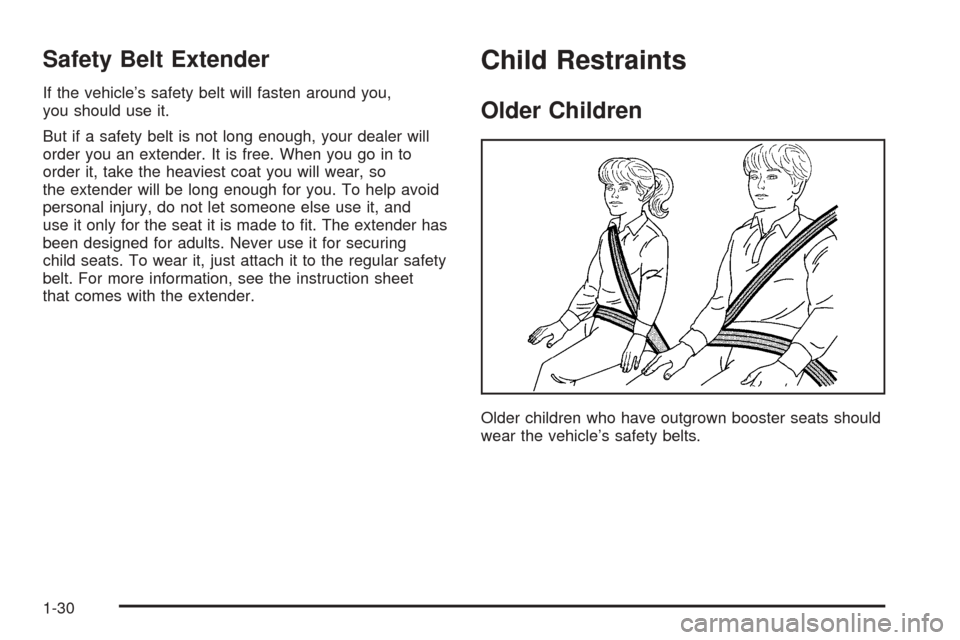
Safety Belt Extender
If the vehicle’s safety belt will fasten around you,
you should use it.
But if a safety belt is not long enough, your dealer will
order you an extender. It is free. When you go in to
order it, take the heaviest coat you will wear, so
the extender will be long enough for you. To help avoid
personal injury, do not let someone else use it, and
use it only for the seat it is made to �t. The extender has
been designed for adults. Never use it for securing
child seats. To wear it, just attach it to the regular safety
belt. For more information, see the instruction sheet
that comes with the extender.
Child Restraints
Older Children
Older children who have outgrown booster seats should
wear the vehicle’s safety belts.
1-30
Page 39 of 382
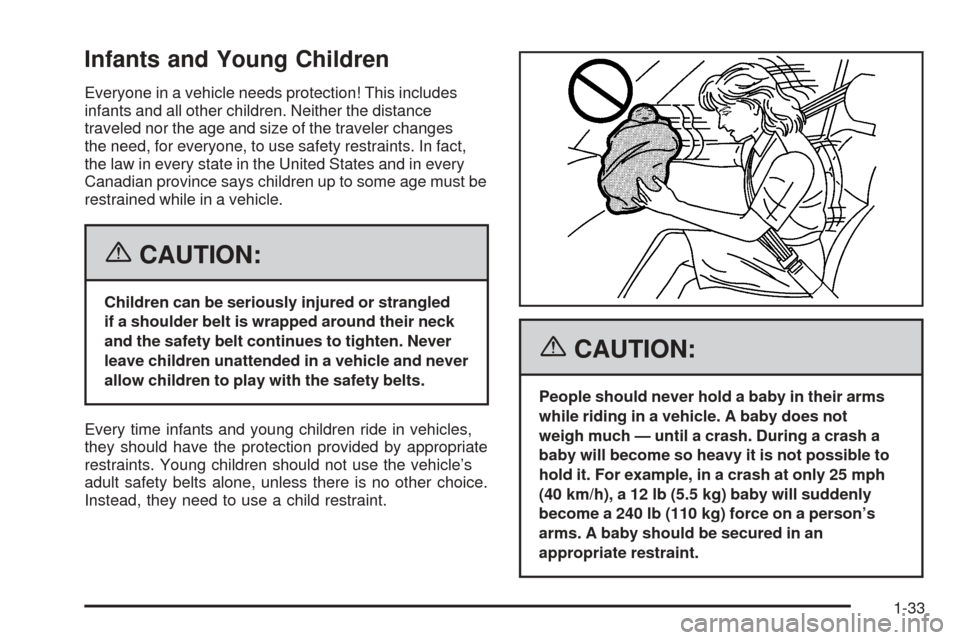
Infants and Young Children
Everyone in a vehicle needs protection! This includes
infants and all other children. Neither the distance
traveled nor the age and size of the traveler changes
the need, for everyone, to use safety restraints. In fact,
the law in every state in the United States and in every
Canadian province says children up to some age must be
restrained while in a vehicle.
{CAUTION:
Children can be seriously injured or strangled
if a shoulder belt is wrapped around their neck
and the safety belt continues to tighten. Never
leave children unattended in a vehicle and never
allow children to play with the safety belts.
Every time infants and young children ride in vehicles,
they should have the protection provided by appropriate
restraints. Young children should not use the vehicle’s
adult safety belts alone, unless there is no other choice.
Instead, they need to use a child restraint.
{CAUTION:
People should never hold a baby in their arms
while riding in a vehicle. A baby does not
weigh much — until a crash. During a crash a
baby will become so heavy it is not possible to
hold it. For example, in a crash at only 25 mph
(40 km/h), a 12 lb (5.5 kg) baby will suddenly
become a 240 lb (110 kg) force on a person’s
arms. A baby should be secured in an
appropriate restraint.
1-33
Page 41 of 382
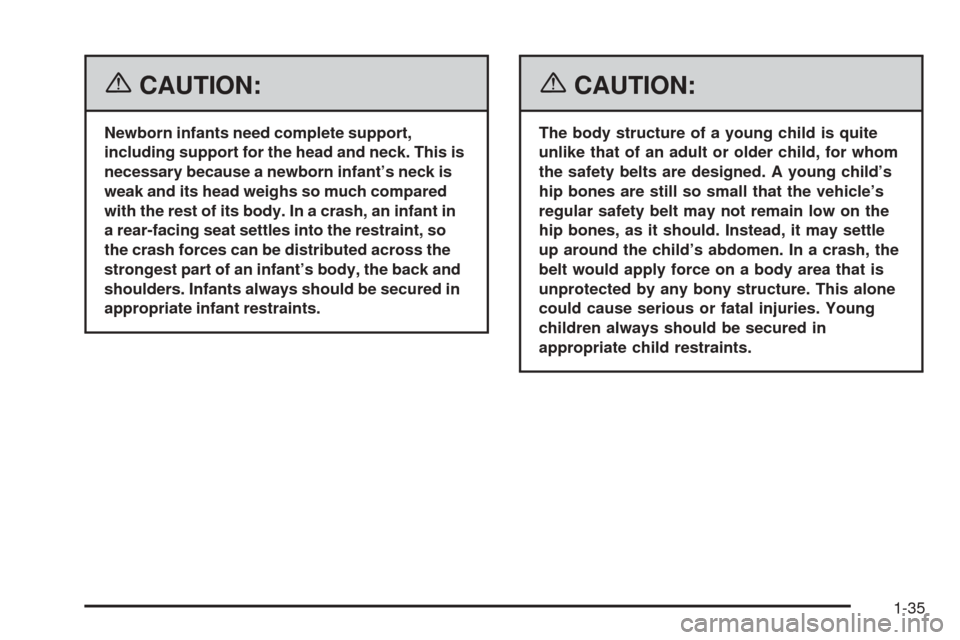
{CAUTION:
Newborn infants need complete support,
including support for the head and neck. This is
necessary because a newborn infant’s neck is
weak and its head weighs so much compared
with the rest of its body. In a crash, an infant in
a rear-facing seat settles into the restraint, so
the crash forces can be distributed across the
strongest part of an infant’s body, the back and
shoulders. Infants always should be secured in
appropriate infant restraints.
{CAUTION:
The body structure of a young child is quite
unlike that of an adult or older child, for whom
the safety belts are designed. A young child’s
hip bones are still so small that the vehicle’s
regular safety belt may not remain low on the
hip bones, as it should. Instead, it may settle
up around the child’s abdomen. In a crash, the
belt would apply force on a body area that is
unprotected by any bony structure. This alone
could cause serious or fatal injuries. Young
children always should be secured in
appropriate child restraints.
1-35
Page 44 of 382
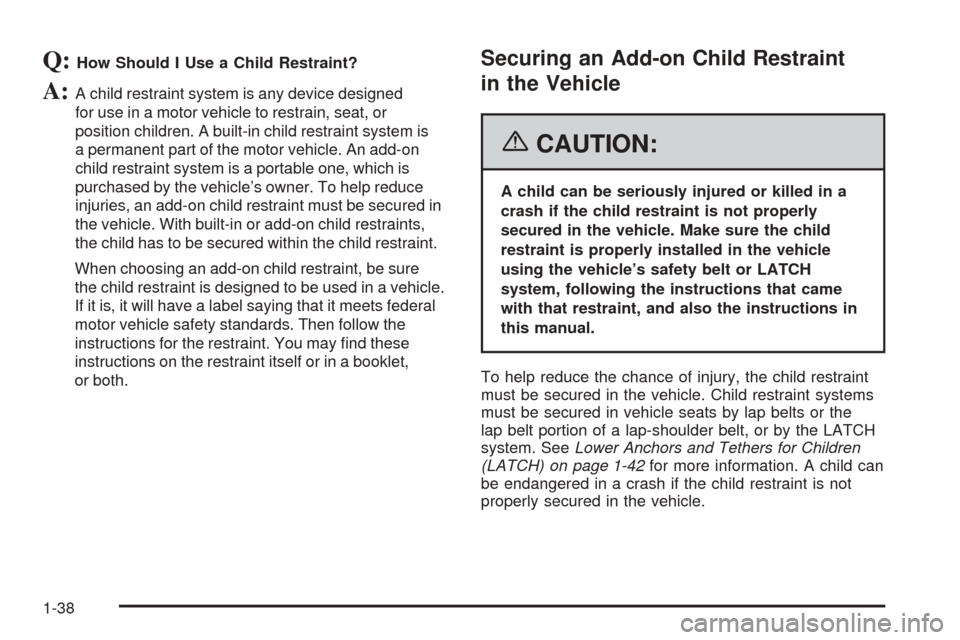
Q:How Should I Use a Child Restraint?
A:A child restraint system is any device designed
for use in a motor vehicle to restrain, seat, or
position children. A built-in child restraint system is
a permanent part of the motor vehicle. An add-on
child restraint system is a portable one, which is
purchased by the vehicle’s owner. To help reduce
injuries, an add-on child restraint must be secured in
the vehicle. With built-in or add-on child restraints,
the child has to be secured within the child restraint.
When choosing an add-on child restraint, be sure
the child restraint is designed to be used in a vehicle.
If it is, it will have a label saying that it meets federal
motor vehicle safety standards. Then follow the
instructions for the restraint. You may �nd these
instructions on the restraint itself or in a booklet,
or both.
Securing an Add-on Child Restraint
in the Vehicle
{CAUTION:
A child can be seriously injured or killed in a
crash if the child restraint is not properly
secured in the vehicle. Make sure the child
restraint is properly installed in the vehicle
using the vehicle’s safety belt or LATCH
system, following the instructions that came
with that restraint, and also the instructions in
this manual.
To help reduce the chance of injury, the child restraint
must be secured in the vehicle. Child restraint systems
must be secured in vehicle seats by lap belts or the
lap belt portion of a lap-shoulder belt, or by the LATCH
system. SeeLower Anchors and Tethers for Children
(LATCH) on page 1-42for more information. A child can
be endangered in a crash if the child restraint is not
properly secured in the vehicle.
1-38